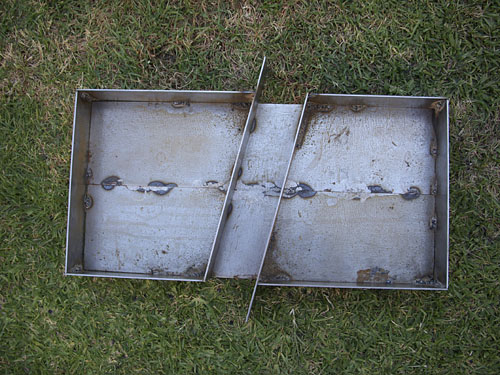Here’s a project that I’ve been thinking about doing for a while, something that I see combines classical bonsai, European topiary traditions, and 60s minimalist art. About a month ago I finally took those thoughts out into the garden. It’s so much a work in progress at this point, but I think you can see where it’s headed.
And here it is from a slight angle:

The “finished” piece is similar to a bonsai grove in most respects, except than I’ve taken a slice out of the center of it. Conceptually I see this closely related to my Destructive Testing photographs, one of which I’ve posted here. And just as the photographs obsess a bit about the human-culture dynamic and issues of control, I see this piece as dealing with similar issues, only in living form.
I started with some sheet steel that I welded into this sculpture/pot (top view):
Angle view:
Then I used standard bonsai techniques to root- and top-prune seven Japanese boxwood plants, and then planted them in a casual orchard formation. Several clumps of elfin thyme complete the composition.
Similar to bonsai, I see this as a multi-year commitment. I intend to pinch the growths frequently to encourage finer branch structure, the quality bonsai people call “ramification.” I want the thyme to fill in more, and I plan to eventually thin the canopy so that you can better see the structure of the “trees.” With time the container will weather to a nicely variegated patina of oxidized steel, and the leaves will diminish in size to heighten the sensation of miniaturization.
Though elevated to a supreme level of “naturalness,” bonsai is heavily about control. People look at the little plants, and quickly see that there’s a human presence under the surface of what they’re viewing. The aims of the art, however, combine the miniaturization with an effort to make the plants even more “natural” than they really are–if that’s possible–and to create a sense of perfect balance and harmony.
The aims of classical European topiary are radically different from bonsai’s. But when people view the shaping, sculpting and meticulous pruning that are so much a part of topiary, they also register that these are all acts of imposing human desires on the natural world.
Whenever this piece is exhibited I’ll do a meticulous trimming of the slice that’s been taken out of the center so that the slicing of the rectangle into two portions is mirrored in the planting above.
Will this combination of an elevated naturalism from bonsai with the blatant geometry of the pot and the shearing and shaping from topiary make the viewer think a bit about how their actions relate to the natural world? I hope so.
I’ll post more in this series once they get to a point worth sharing…




raising up bonsai is a good hobby. it will bring out the artistic touch in you. You can use the bonsai to design something in your mind to help you relax a little bit. it’s a good duo with hydroponics. both of them don’t need spacious backyard.. aside from doing hydroponic farming, Im shaping up bonsai during my spare time.
Hydroponic gardening, is only as difficult as you make it. It can be complicated, if computers with sensors are used to control water cycles, nutrients, and light for the plants.